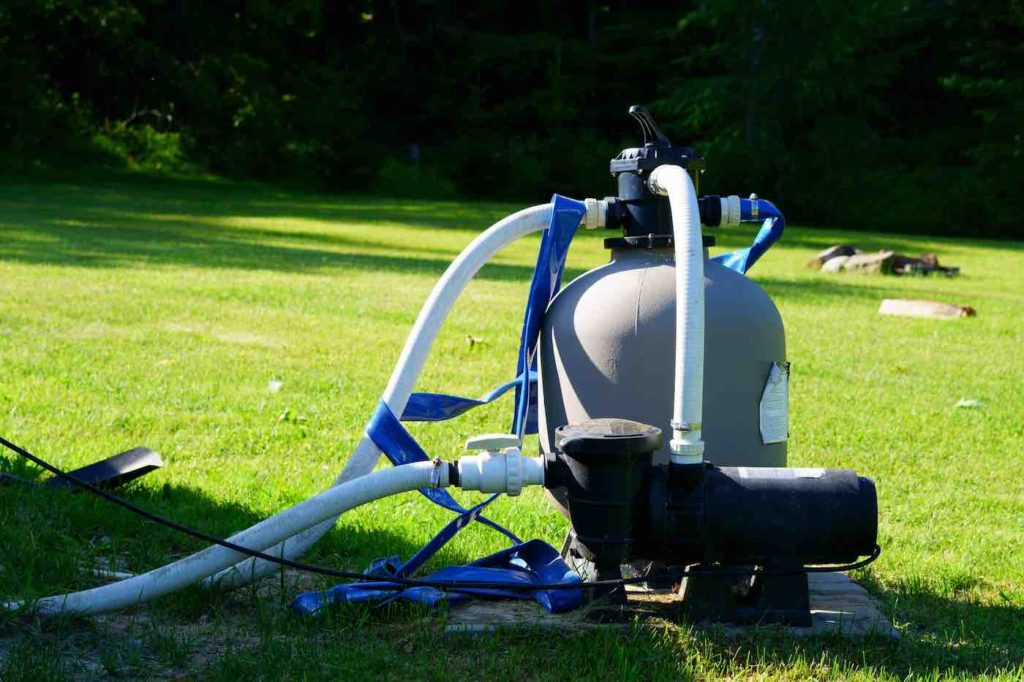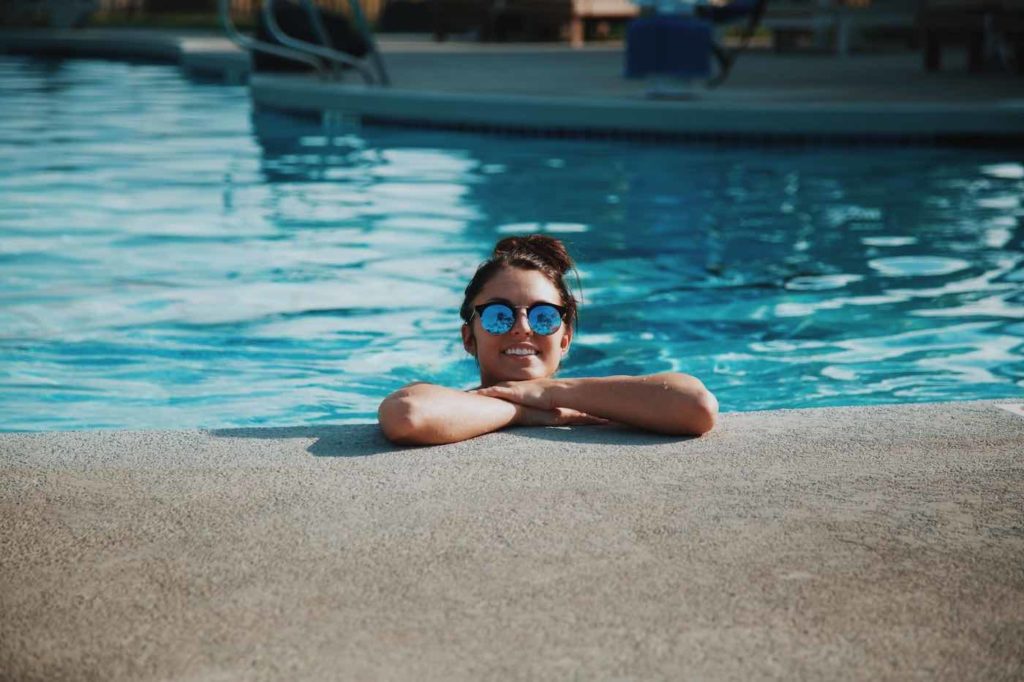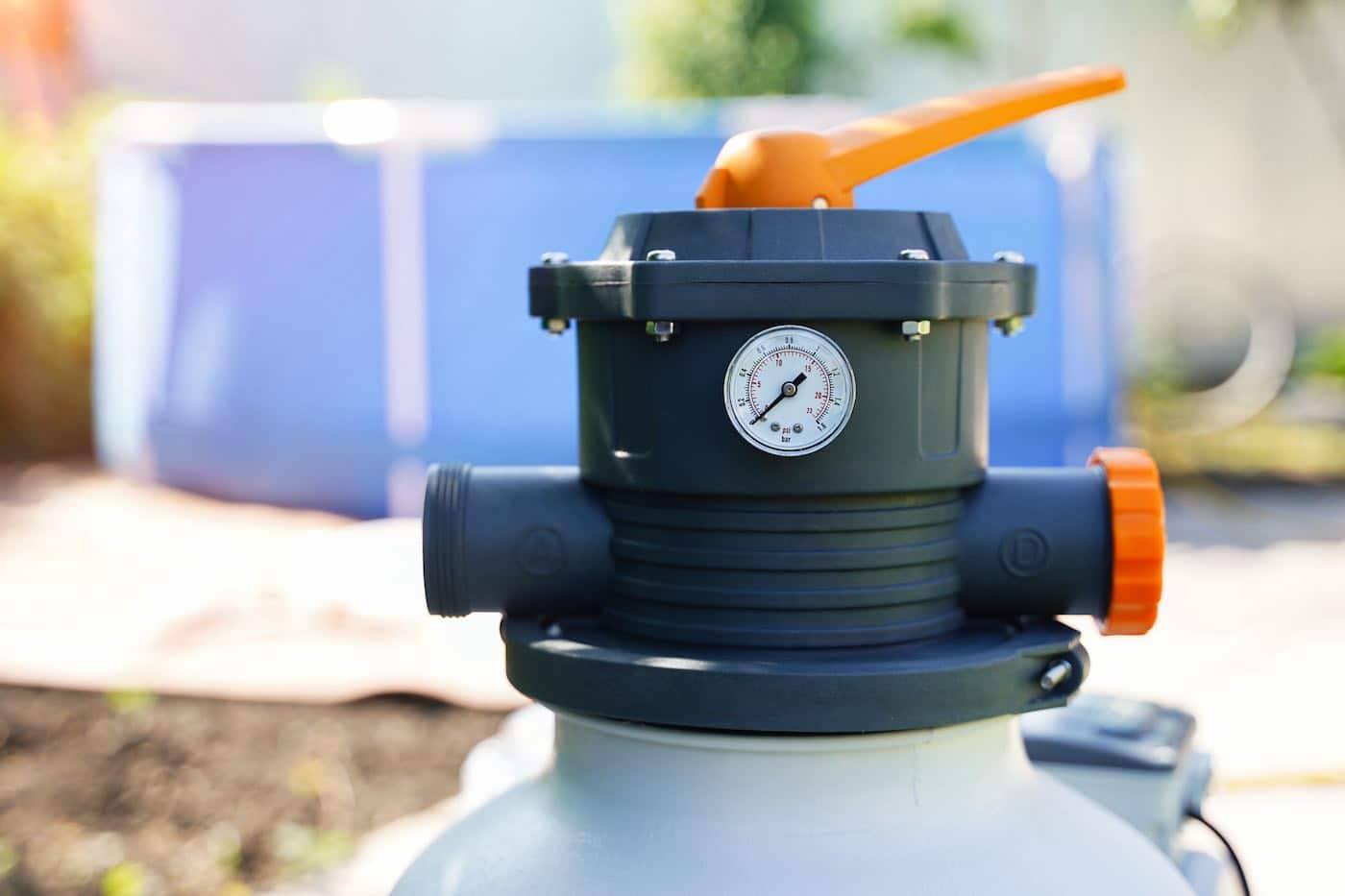Lost your owner’s manual on how to properly backwash your pool filter? Used to hiring an expert pool maintenance person, but now you want to try doing it yourself?
We got you!
Backwashing your pool filter is an important part of overall pool maintenance, and it may sound hard, but it’s SUPER EASY to do!
This article will walk you through ALL the SIMPLE steps of backwashing a pool filter and the different process versions depending on your pool’s filter type!
Ready? Let’s get started!
When Do You Need to Backwash Your DE Pool Filter?
You usually need to clean out your de filter system when it’s higher than 10-pound force per square inch (psi).
Take a look at your pressure gauge.
It will show you your clean and dirty pressure and check if your pressure gauge says your water is 10 psi above the clean pressure.
How Much DE Powder Will You Need?
First, you need to find out the size of your DE filter tank. If you look at the tank, there’s a label that says DEP and a number, like DEP80.
This means there are 80 square feet in the filter system. Use this to calculate the recommended amount of DE powder needed.
Your DE powder will come with instructions, so take that recommended amount and only use 80% of what is indicated (most recommended amounts tend to be too much).
How to Backwash Pool Filter: DE Filter Version
Here’s how to backwash using a multiport valve:
Step 1: Connect the Backwash Hose to the Filter’s Backwash Port
Take your waste line and connect it to the filter’s waste port. Then extend it until you reach a place where you won’t accidentally take a shower while cleaning.
Now, turn OFF the pool pump and put it on FILTER mode.
Open the backwash gate as well.
Then you can move your multiport valve over to the BACKWASH position. Never move your multiport valve before turning off your system!
Push the handle locks down and rotate the backwash valve clockwise.
Step 2: Reverse the Filter System
Next, turn the pool pump in REVERSE, then turn it ON. This will reverse the water flow in the filter to clean the filter grids.
The water will now come out of the backwash hose, and you’ll see the dirty DE water come out.
There’s no set time for how long you should let the pool pump run, so let the cloudy water come out until ALL the DE is gone and the water comes out clean.
If you have a sight glass, you can monitor the water status.
Step 3: Turn off the Pump
Now, turn the filter system OFF and move the multiport valve over to the RINSE setting.
The rinse setting will let the pool water pass through the filter’s regular flow while exiting through the waste line.
Then let it run for about 30 seconds.
This rinsing process is VERY IMPORTANT in cleaning the pool filter.
If you skip it and go straight to the FILTER after the backwash, you will send the remaining dirty water in the backwash hose back into the pool.
Step 4: Backwash Again
Just because you got rid of the cloudy water the first time doesn’t mean it’s enough.
You need to repeat the backwash-rinse process a few more times to get all that stubborn DE powder out.
Do this until the water in the sight glass is CLEAR.
When you’re sure it’s all clean, it’s time to turn OFF the pump again.
Step 5: Return the Valve to the Filter
You’re done cleaning the filter system, and you can return it to the normal FILTER mode again.
Turn the filter valve ON again, and then it’s time to recharge it with a DE pool filter!
Step 6: Refill the DE Pool Filter
Get your materials ready:
- Diatomaceous earth
- Bucket large enough to mix the diatomaceous earth in
- DE scoop
- Rubber gloves
Next, using your scoop, take the appropriate amount of DE powder and put it in the bucket.
Now, take the SAME AMOUNT of water as your DE and mix it in your bucket. Mix it with your hands (wearing your gloves!) until the consistency is similar to oatmeal.
After mixing the DE, pour it SLOWLY into the skimmer while the filter system is running so that it can coat the grids.
Step 7: Check Your Work
You’re all done! Now all that’s left is to observe.
Check the water flowing into the pool. If you don’t see any DE going back into the water, then congratulations, you did well!
You now have a clean and normal operating filter pressure!
Now for the sand filter pool owners…

How to Backwash Your Pool: Sand Filter Version
This backwash process is also for multiport valve pool owners:
Step 1: Turn off the Pump
You first need to attach the backwash hose to the backwash port like in the previous backwash process.
Open your equipment panel and turn the filter OFF. You will also need to turn OFF the sweep booster.
Step 2: Set the Filter Valve Handle to Backwash Setting
Rotate your filter valve until it reaches the BACKWASH setting and locks it in place. You usually have to turn the multiport valve 180 degrees.
Step 3: Turn the Pool Pump On
Go back to your equipment panel and turn the pool pump ON again. This will let the dirty backwash water come out through the hose.
And like the DE version, you stop when clear backwash water comes out, or you see clearer water through the sight glass.
Step 4: Rinse
Turn the pump OFF again and move your valve to the RINSE setting. This lets the water come out the normal way and rids of the debris caught in the hose.
Let it run until the pool water that comes out is clean.
Step 5: Return to Pump Filter Setting
Turn OFF the pump, and return the valve to the FILTER setting.
Then turn the pump ON again, and you’re done!
How Do You Know When to Backwash Your Pool Filter?
A pool sand filter should go through the backwashing process every 2 to 4 weeks, while you should backwash a pool using DE filters every 4 to 6 weeks.
And also after the pool gets vacuumed.
But if you lose track of the weeks or your pool has been especially busy lately with swimmers, these factors will tell you when to backwash a pool:
Clarity of Pool Water
This is the first thing you’ll probably notice as the pool owner. One look at your cloudy water, and you know your pool filter needs some cleaning.
Visibly dirty pool water is usually a result of a backed-up or clogged filter, so that a backwash will solve this problem.
The flow of Pool Water
The accumulation of dirt and debris in most pool filters will also cause pool water flow to slow down.
If you notice that the pool water flows slower than usual, it’s probably time for a pool filter backwash.
Pool Water Pressure
In contrast to the flow of pool water, if you notice that your pool water pressure reading is higher than usual, it’s time for a backwash.
The pressure increases when the filter system is clogged up and is straining to perform.
A good indicator of when to backwash a pool is when you see the pressure gauge read 10 psi higher than normal.
If you think it’s time to replace the filter, read our article about how to choose the best pool filter.
Which Is the Better Filter Media? Pool Sand Filter vs. DE Filter
Take a look at each of these factors to help you decide between the sand and DE filters:
Cleaning Power
DE wins this round.
If you don’t want to keep your pool clean but crystal clear, DE should be your pool filter instead of sand.
DE filters can strip your water of the smallest dirt particles, even those that a sand filter can not take out.
Price
Sand filter is the winner here.
Because it can take out most of the dirt particles, the DE filter is also the more expensive pool filter.
The amount of DE you will need to coat your filter grids will also be bigger than a pool sand filter.
Maintenance
Sand filter wins this round again.
Backwashing your pool filter is similar for both filters, but a DE pool filter will require more time and effort for pool maintenance.
How Can You Reduce Wasted Water When Backwashing?
Using a sand filter will waste more water than other forms of filter. Here are some of the ways you can save water:
Turn the Valve as Soon as the Water Clears Up
To avoid wasting more water than usual, monitor it as it comes out and shut the pump off as soon as you see clear water flowing out.
Doing this will ensure that you won’t overdo the backwashing of your filter and not strain the filter as well.
Don’t Prolong the Backwashing
The sand filter system also works best in the middle of its filter cycle.
This is because of the position of the dirt that accumulates in the filter and also due to the placement of the sand in the filter at any given time.
So overdoing the backwash process is counterproductive since it will eventually reduce the performance of the sand filter.
Double Check the Pump
During the entire sand filter backwashing process, don’t forget to double-check the pump when you change the settings and when you finish backwashing.
Ensure you have turned it OFF at the right steps and that it’s back to regular sand filter mode when you’re done with all the cleaning.
Recommended read: “How to Clean a Swimming Pool Without Chemicals”

Frequently Asked Questions
Still got more questions on pool filter backwash, the best filter for you, or pool care in general?
We have all the answers here!
This depends on your location and the local government’s regulations.
Dirty pool water usually can’t be disposed of through the septic system because it’s chemically treated and will kill the enzymes designed to kill the waste in its water.
You might need to treat the water again and dispose of it in one of your plumbing cleanouts, storm drain port, or even contain and take it to a special facility.
It’s best to ask your local government for information on this.
Backwashing your pool filters regularly, whether it’s a sand pool filter or a DE pool filter, will significantly increase the life and effectiveness of your DE or sand filter.
If a pool remains unfiltered, you will risk having many uncertain diseases that can infect your pool, but you will also have a harder time maintaining your pool due to the dirt!
When you backwash your pool filters, it cleans your filter and lessens the frequency of replacing your sand or DE material, saving you money!
Your hardworking DE filter or sand filters will eventually accumulate dirt and debris from sunscreen, makeup, sweat, and more in your pool water.
And when your DE and sand filters are filled with dirt and debris, they won’t be able to work as well in keeping your pool water clean.
Backwashing only works for sand or DE filter systems, and it works by reversing the flow of water to unclog the filter grids of the accumulated dirt and debris.
Doing this will let your DE or sand filter work more effectively and also prolongs the life of your sand or DE.
So make sure to backwash your pool regularly!
Since pool water gets dirtied by dirty air, falling leaves and other debris, one thing you can do for swimming pool maintenance when no one is swimming is to cover it.
You can invest in a pool cover, so your filter medium has less work. Although making the maintenance easier sounds better and more convenient, maximum maintenance is still the way to go if you want your pool to be as clean as possible!
If your pool hasn’t been used for a time or has been dirtied too much for some reason, it might be better for pool care to by pass the filter system and vacuum directly.
Having all that dirty water go through the pool filter might be too much work for your DE or sand filter, and it might not even be cleaned enough.
Sometimes, it’s better to toss all that water out for sanitation and filter care purposes.
Yes, if you switch to a cartridge filter system.
Cartridge filters aren’t built for water flowing in the opposite direction, so you must clean them.
However, this pool filter is much easier to maintain and can even clean your pool water better than a sand filter.
If you overdo backwashing by running it too long or doing it too often, you will waste water and strain your filter system. So be careful, or you’ll end up with more problems!
Cartridge filters!
The process of backwashing a pool wastes a LOT of water unnecessarily. So if you’re committed to saving on your water bill (and the environment), consider switching to a cartridge filter system for your pool, as it eliminates the need for backwash.
This pool filter also uses the least amount of energy and is the easiest to maintain. But it is also the most expensive.
But between sand vs. DE filters, they both waste about the same amount of water.
Generally, NO. But…
Sometimes, sand unexpectedly ends up in the wrong places while you refill them. Then it goes into the pool or sometimes out through the backwash hose.
When it ends up in the backwash hose, you lose that sand when you start backwashing.
YES. Whether they are sand or DE filters, bigger filters perform better and require less maintenance.
This is because the smaller the filter, the higher the pressure. And the higher the pressure is, the more strain it will put on your filter system.
Higher pressure also means more frequent backwashing, so you’ll need more effort and time for maintenance.
But bigger filters also come with higher price tags, so keep that in mind when choosing your pool filter size.
In Conclusion
Backwashing your pool is an EASY and FAST process.
Forget about hiring an expert pool maintenance person. You can now do it ALL by yourself without breaking a sweat!
Now that you know how to do it well don’t forget to do it regularly for an always clean, crystal clear pool.
Go and reward yourself with a relaxing swim. You deserve it!
